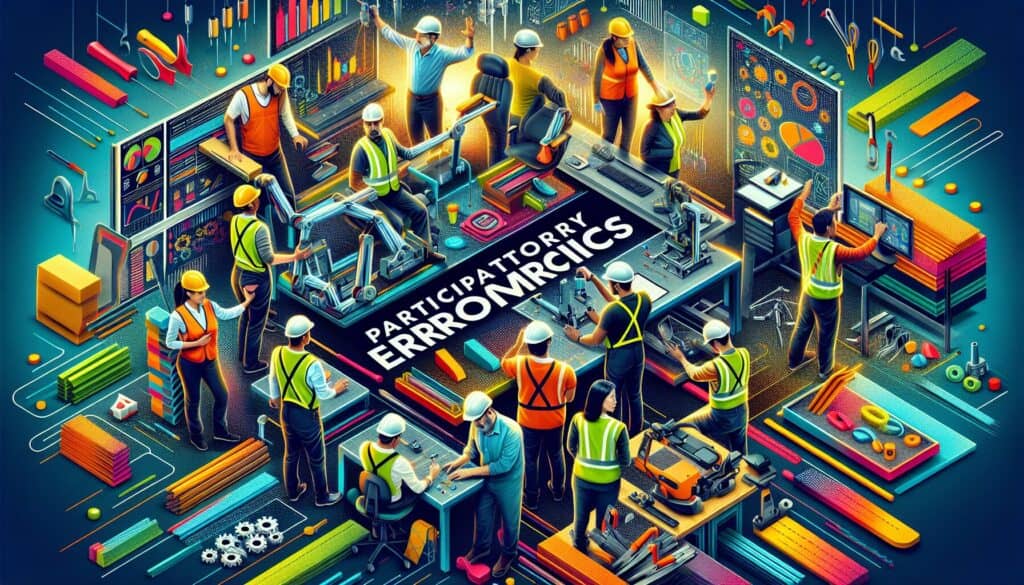让工人积极参与识别、分析和控制工作 人体工学 自己的工作和工作环境中的风险。
- 方法: 经济学, 精益西格玛, 制造业, 解决问题, 质量
参与式人体工程学(让工人参与其中)

- 持续改进, 人体工程学, 人为因素, Human-Centered Design, 精益制造, 解决问题的技巧, 流程改进, 团队合作, 以使用者為中心的設計
参与式人体工程学(让工人参与其中)
- 持续改进, 人体工程学, 人为因素, Human-Centered Design, 精益制造, 解决问题的技巧, 流程改进, 团队合作, 以使用者為中心的設計
目标
如何使用
- 组建由工人、主管和人体工程学专家组成的团队,共同确定人体工程学问题,集思广益找出解决方案,并实施和评估改进措施。
优点
- 提高工人对解决方案的认同感和主人翁意识;利用工人对其任务的直接了解;通常会产生更实用、更可持续的解决方案。
缺点
- 管理参与过程可能耗费时间;需要对工人和管理人员进行培训;如果没有很好地促进,可能会出现意见冲突或提出不切实际的建议。
类别
- 人体工程学, 制造业, 质量
最适合:
- 让员工直接参与发现和解决工作场所人体工程学问题的过程。
Participatory Ergonomics is particularly beneficial in sectors such as manufacturing, healthcare, and office environments, where physical tasks and workspace layouts significantly impact worker safety and productivity. During the design phase of a new workspace or equipment, this methodology can be implemented effectively through workshops and brainstorming sessions involving a diverse team of employees who perform the tasks, supervisors who manage workflows, and ergonomics experts who understand the principles of optimal design. The collaboration among these participants not only allows for a comprehensive identification of ergonomic challenges but also encourages innovative solutions grounded in real-world applications. Various industries have successfully adopted this approach to enhance job satisfaction and productivity while reducing workplace injuries; for example, in manufacturing, workers can provide feedback on machinery layouts and tool accessibility, while in healthcare, nursing staff can identify challenges in lifting techniques or equipment placement that affects patient care. Engaging employees in this manner fosters a culture of continuous improvement as they become invested in the solutions they help create, making it more likely that changes will be implemented effectively and maintained over time. When teams regularly evaluate the changes made and solicit further input, an ongoing dialogue is established, promoting adaptability as tasks and technologies evolve. The success of these initiatives often leads organizations to establish permanent ergonomic committees or task forces that regularly assess workplace conditions and champion employee-driven improvements.
该方法的关键步骤
- Identify ergonomic issues through interactive discussions with workers.
- Engage in brainstorming sessions to generate ideas for improvements.
- Prioritize identified solutions based on feasibility and impact.
- Develop action plans for implementing selected solutions collaboratively.
- Execute the action plans while involving workers in the process.
- Monitor and assess the impact of implemented solutions with worker feedback.
- Iterate on solutions based on evaluation results and ongoing worker input.
专业提示
- Conduct regular workshops that allow workers to voice concerns and suggest feasible ergonomic enhancements, fostering an ongoing dialogue around workplace safety.
- Utilize collaborative tools and visual aids like sketches or 3D models during brainstorming sessions to guide discussions toward tangible solutions.
- Establish metrics for evaluating ergonomic interventions, ensuring feedback loops are in place for continuous improvement based on real-world applications and user experiences.
历史背景
1986
(如果日期不详或不相关,例如 "流体力学",则对其显著出现的时间作了四舍五入的估计)。

相关文章
蒙特卡罗模拟
基于模型的测试
型号检查
混合方法研究
防错(Poka-Yoke)
任务简介测试